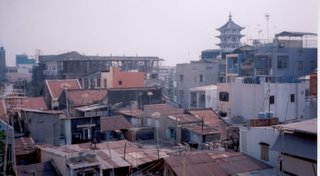A Ravaged Country

The War Remnants Museum may have changed its name from The American and Chinese War Crimes Musuem, but the former title is still the more fitting. Located in a quiet street near the city centre, the musuem highlights all the well-known atrocities the American's committed (the My Lai massacre, Agent Orange devastation, heavy bombing strategies) without mentioning a single-incident painting the North Vietnamese Army in a bad light.
Communist societies probably have a worse record at providing a balanced, fair assessment of events than non-Communist ones, but the museum is really just another stark reminder that in any conflict, truth is as much a casualty as the people.
Bearing that in mind, the museum is still a powerful illustration of what war means at the level of individuals and the suffering and madnesses they have to endure. The most chilling photo is of two American soldiers grinning like wild men while holding aloft the recently decapitated heads of two of their enemy. To me it shows how far ordinary men, outside of many of the controls of civilized society, can have their moral resources eroded to the point at which a human becomes less than an animal.
Additional exhibits of deformed foetuses--killed by exposure to Agent Orange--preserved in jars of formaldehyde, helped to show how the technologies of modern warfare can have the most devastating consequences for ordinary men and women. I hope one day the human race will become mature enough to renounce violence because in the not-too-distant future there will be weapons created that no enforceable level of security will be able to contain. It is only through a universal agreement to not develop these technologies that we'll be able to have a worldwide peace.
Whatever you're opinions about the use of war as a means of settling disputes, the human cost should always be borne in mind, and a museum such as this one does a brilliant job of cataloguing that cost.
After the museum I walked a good part of the city, trying to get a sense of the place. The city seemed deserted, but perhaps that was because tonight marked the beginning of the Chinese New Year and many people were probably at home or visiting relatives in the countryside. The scars of the war, which ended less than thirty years ago, are still painfully visible everywhere in the urban landscape. The damage is primarily economically caused; splintered pavements, decaying buildings needing urgent renovation, and potholed roads. And this is in the city centre.
I walked over one of the bridges that crosses the ponderously-moving Saigon River, and hit an even more degenerated area. Here I ducked into a typical Vietnamese diner and enjoyed some fat spring rolls, a seafood dish in a fish sauce called nuoc mam and a drink all for less than forty pence. Talking of food, one curiosity is the culinary legacy of the French occupation. It is probably the easiest place in Asia to find baguettes and good coffee!
Back at Miss Loi's I met an English guy called Francis, who'd been travelling for a while through other parts of South East Asia. We went to a vegetarian restaurant called The Bodhi Tree (a fig tree under which the Buddha gained enlightenment), and during the conversation I learnt Francis had once been a software engineer at Vega (the first company I worked for) too! What a coincidence--although if there was one company to put a person off IT and go travelling around the world it was Vega.
After dinner we went to the 'Bamboo Bar', a pub at one end of Ho Chi Minh City's own Khao San Road--only this road was smaller and dirtier. It seems that what the average traveller wants most, is to feel like he is back home, minus the bad weather. This means every tourist bar is a dead-ringer for a bar back home. Any elements of the country's own particular brand of alcohol consuming establishment are lost in the effort to make the bar as similar to the ones back home. Not that I don't like English pubs, it's just I want to see how things are different here. Mental note to get away from the tourist spots when I can.
At Miss-Loi's we camped out on the roof and waited for midnight and the fireworks to bring in the New Year. Enjoyable except for the American girl who had to sit on the roof's wall and make me nervous that she was going to fall. Back downstairs we ate some traditional New Year foods which included hybrid fish/rice cakes which tasted disgusting.
When asked how they tasted I, of course, said they were delicious, not wanting to belittle my host's efforts.
Their reaction? They laughed.
Later I found out the dish was intentionally bad as it symbolised the hardships endured in the creation of Vietnam.
Maybe brussel sprouts fulfill a similar role in the UK.



0 Comments:
Post a Comment
<< Home